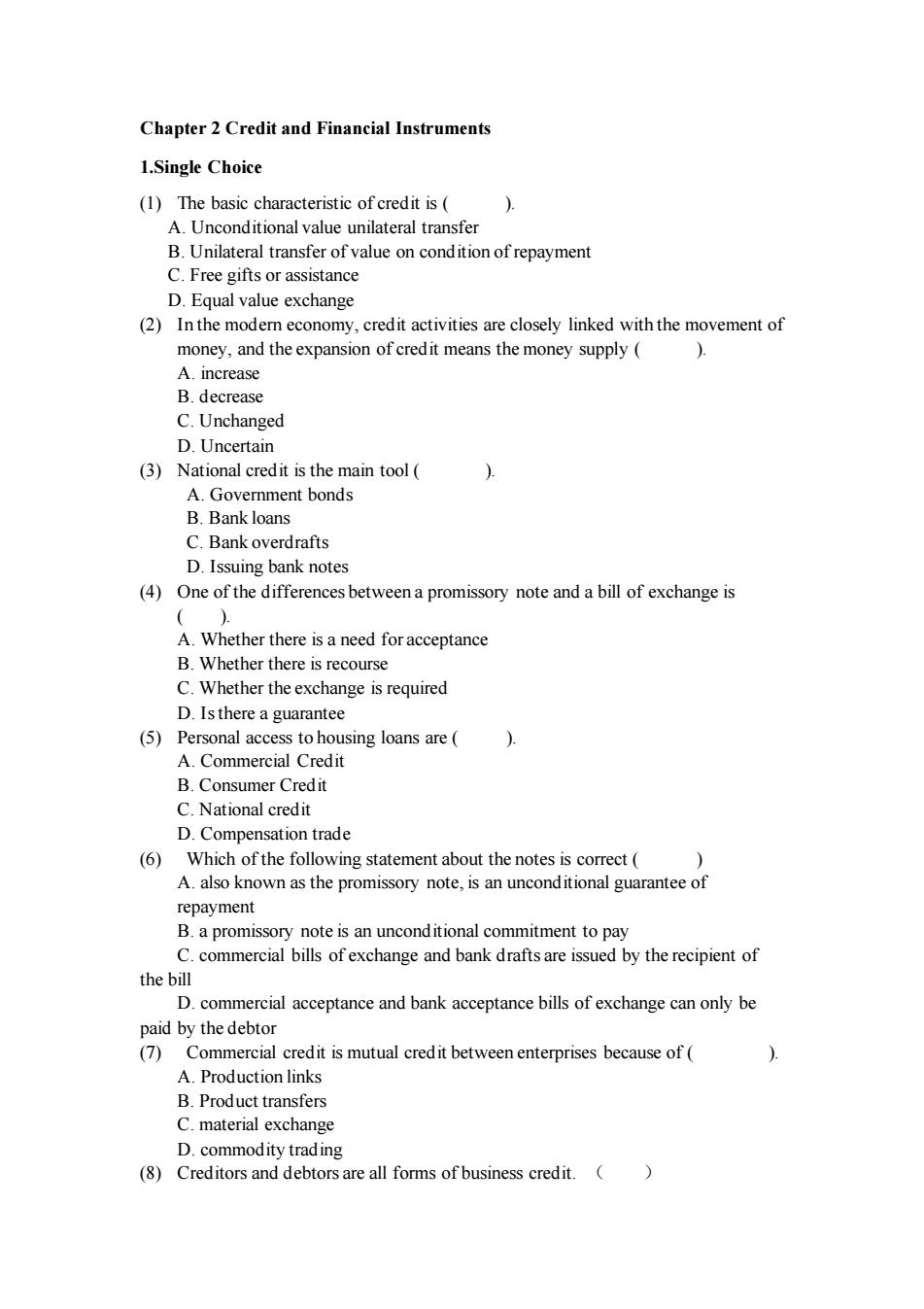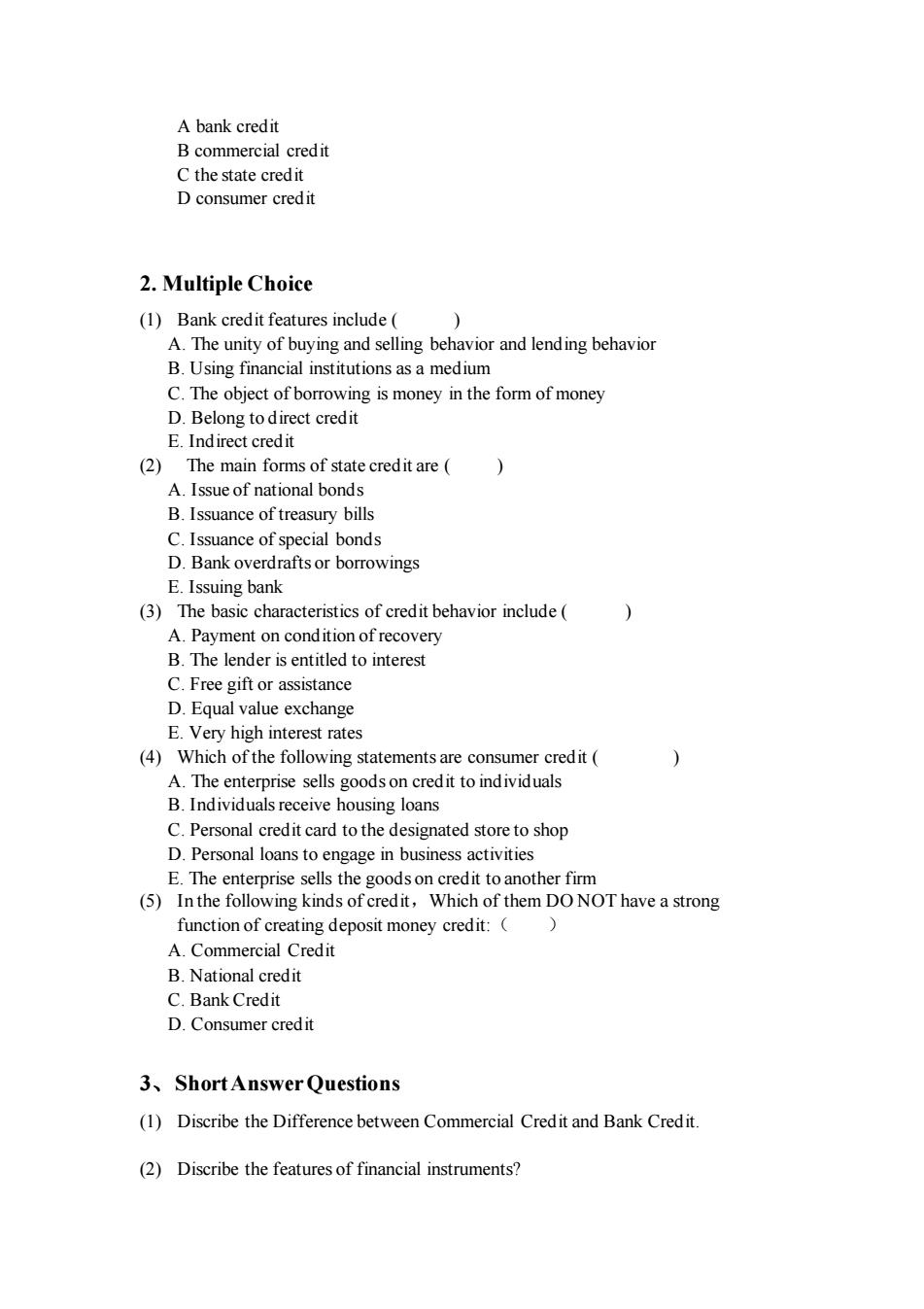
Chapter 2 Credit and Financial Instruments 1.Single Choice (1)The basic characteristic of credit is () A.Unconditional value unilateral transfer B.Unilateral transfer of value on cond ition of repayment C.Free gifts or assistance D.Equal value exchange (2)In the modern economy,credit activities are closely linked with the movement of money,and the expansion of credit means the money supply () A.increase B.decrease C.Unchanged D.Uncertain (3)National credit is the main tool A.Government bonds B.Bank loans C.Bank overdrafts D.Issuing bank notes (4)One of the differences between a promissory note and a bill of exchange is A.Whether there is a need for acceptance B.Whether there is recourse C.Whether the exchange is required D.Is there a guarantee (5)Personal access to housing loans are () A.Commercial Credit B.Consumer Credit C.National credit D.Compensation trade (6)Which of the following statement about the notes is correct ( A.also known as the promissory note,is an uncond itional guarantee of repayment B.a promissory note is an uncond itional commitment to pay C.commercial bills of exchange and bank drafts are issued by the recipient of the bill D.commercial acceptance and bank acceptance bills of exchange can only be paid by the debtor (7)Commercial credit is mutual credit between enterprises because of A.Production links B.Product transfers C.material exchange D.commodity trading (8)Creditors and debtors are all forms of business credit.(
Chapter 2 Credit and Financial Instruments 1.Single Choice (1) The basic characteristic of credit is ( ). A. Unconditional value unilateral transfer B. Unilateral transfer of value on condition of repayment C. Free gifts or assistance D. Equal value exchange (2) In the modern economy, credit activities are closely linked with the movement of money, and the expansion of credit means the money supply ( ). A. increase B. decrease C. Unchanged D. Uncertain (3) National credit is the main tool ( ). A. Government bonds B. Bank loans C. Bank overdrafts D. Issuing bank notes (4) One of the differences between a promissory note and a bill of exchange is ( ). A. Whether there is a need for acceptance B. Whether there is recourse C. Whether the exchange is required D. Is there a guarantee (5) Personal access to housing loans are ( ). A. Commercial Credit B. Consumer Credit C. National credit D. Compensation trade (6) Which of the following statement about the notes is correct ( ) A. also known as the promissory note, is an unconditional guarantee of repayment B. a promissory note is an unconditional commitment to pay C. commercial bills of exchange and bank drafts are issued by the recipient of the bill D. commercial acceptance and bank acceptance bills of exchange can only be paid by the debtor (7) Commercial credit is mutual credit between enterprises because of ( ). A. Production links B. Product transfers C. material exchange D. commodity trading (8) Creditors and debtors are all forms of business credit. ( )

A bank credit B commercial credit C the state credit D consumer credit 2.Multiple Choice (1)Bank credit features include( A.The unity of buying and selling behavior and lending behavior B.Using financial institutions as a medium C.The object of borrowing is money in the form of money D.Belong to direct credit E.Indirect credit (2)The main forms of state credit are A.Issue of national bonds B.Issuance of treasury bills C.Issuance of special bonds D.Bank overdrafts or borrowings E.Issuing bank (3)The basic characteristics of credit behavior include( A.Payment on condition of recovery B.The lender is entitled to interest C.Free gift or assistance D.Equal value exchange E.Very high interest rates (4)Which of the following statements are consumer credit A.The enterprise sells goods on credit to individuals B.Individuals receive housing loans C.Personal credit card to the designated store to shop D.Personal loans to engage in business activities E.The enterprise sells the goods on credit to another firm (5)In the following kinds of credit,Which of them DO NOT have a strong function of creating deposit money credit:() A.Commercial Credit B.National credit C.Bank Credit D.Consumer credit 3,Short Answer Questions (1)Discribe the Difference between Commercial Credit and Bank Credit. (2)Discribe the features of financial instruments?
A bank credit B commercial credit C the state credit D consumer credit 2. Multiple Choice (1) Bank credit features include ( ) A. The unity of buying and selling behavior and lending behavior B. Using financial institutions as a medium C. The object of borrowing is money in the form of money D. Belong to direct credit E. Indirect credit (2) The main forms of state credit are ( ) A. Issue of national bonds B. Issuance of treasury bills C. Issuance of special bonds D. Bank overdrafts or borrowings E. Issuing bank (3) The basic characteristics of credit behavior include ( ) A. Payment on condition of recovery B. The lender is entitled to interest C. Free gift or assistance D. Equal value exchange E. Very high interest rates (4) Which of the following statements are consumer credit ( ) A. The enterprise sells goods on credit to individuals B. Individuals receive housing loans C. Personal credit card to the designated store to shop D. Personal loans to engage in business activities E. The enterprise sells the goods on credit to another firm (5) In the following kinds of credit,Which of them DO NOT have a strong function of creating deposit money credit:( ) A. Commercial Credit B. National credit C. Bank Credit D. Consumer credit 3、Short Answer Questions (1) Discribe the Difference between Commercial Credit and Bank Credit. (2) Discribe the features of financial instruments?